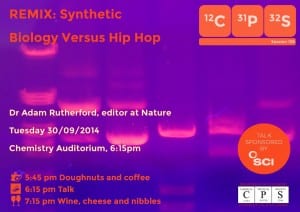Rhythm and Base Pairs – CPS Talk 30/09/14
By Penny Carmichael, on 6 October 2014
– Article by Stephen Leach
In the first of the weekly CPS talks this year, Dr Adam Rutherford visited the UCL Chemistry Department to discuss the unlikely companions of genetics and hip hop. As a conscientious biologist and geneticist he opened with a cautionary tale about incest. The Habsburg Dynasty of Spain (who ruled Spain between 1516 and 1700) had a family tree resembling more of a family web. ‘The Habsburg Jaw’ was their treasured facial feature and for this distinctive chin they risked the fertility and health of their descendants, inevitably ending their reign. Charles II, the last Habsburg, died heirless at 38; his jaw couldn’t save him. Genetics is hinged on the relation between the genotype (the genetic material) and the phenotype (the physical result of the expression of the gene). Hence the Habsburg Jaw is the phenotype for the expression of one or many genes which had been intimately shared around the family. In their defence, Dr Rutherford concluded the tale by reminding us that nobody is perfectly outbred.
Once this connection had been made, the curious scientist wondered about the possible transfer of genetic material between organisms in order to control novel unnaturally occurring characteristics. This is not a new idea; The Chimera, (a hybrid animal which is composed from parts of others) was originally found in Greek mythology and is often used in heraldry. ‘The Enfield’ for example, a chimera with the head of a fox, the body of a lion, an eagle’s talons and the ass of a wolf appaears in the London Borough of Enfield’s coat of arms. Human-like chimeras are found in H.G. Wells’ 1896 novel ‘The Island of Dr. Moreau’, which questions of how far science should interfere with nature, although it was vivisection at the time which had inspired its plot.
When Darwin wrote “The Origin of Species”, he chose to tread fairly carefully; he personally didn’t want to initiate a full renegotiation of the prevalent religious doctrine of the times. Hence the book opens with a chapter on Pigeon Fanciers, entitled “Variation Under Domestication” and presents incredibly lucid argument for his theory in the context of the controlled breeding of pigeons, which was at the time ubiquitous. The breeders select the phenotype they wish to preserve and allow that individual to breed; unnatural selection. If the phenotype was being preserved, then so must the genotype.
In nature, genetic material can be mixed by breeding or by the mechanisms of viruses, but in the modern laboratory genetic material can be shared with much greater control. Examples were given of some amazing current technologies: a plant which has been genetically modified to grow purple instead of green when in the presence of land mines. Yeast cultures which secrete diesel. Genetic logic based circuits which ‘calculate’ whether a cell is cancerous and if so, instruct it to kill itself.1
Finally that brings us to the hip hop analogy which serves to illustrate the idea that the progress/development/evolution of ‘a thing’ is propagated by the sharing or transfer of material. This analogy takes flight upon the recognition that early hip hop was built on samples, that is, pre-recorded music from another artist re-expressed in a new context resulting in a novel characteristic sound. The reorganisation of material had enlivened and enriched the final product, making it ‘fitter’ than its competitors. The creators of the chimera were DJ’s of the dark ages, mixing not beats but beasts. Darwin’s pigeon fanciers are like music producers, tuning and honing not the beats but the beaks and breasts.
As for the modern examples, the analogy changed. Genetic research brings with it ethical problems, while at the apex of hip hop were legal problems. In order for hip hop to become the hugely lucrative enterprise it now is, there had to come a restriction on the sharing of material, ownership and licensing were ushered in; survival of the richest. Dr Rutherford suggested that this meant the end of the genre, having lost its mechanism to freely exchange material. Although perhaps ‘speciation’ had taken place and the genre has not died, but changed its habitat. A similar struggle occurred in the biosciences as companies attempted to become legal owners of genetic material. Thankfully this has yet to occur. In genetics and hip hop such restriction could be considered stifling.
Dr Rutherford’s favourite rapper is Tupac Shakur, that’s an exclusive. However he chose to conclude with a quote from the American activist and Professor of Law; Lawrence Lessig:
“A culture free to borrow and build on the past is culturally richer than a controlled one.”
References:
- See Xie et al. 2011 ‘Multi-input RNAi Based Logic Circuit for Identification of Specific Cancer Cells’
 Close
Close



 Subscribe to this blog!
Subscribe to this blog!